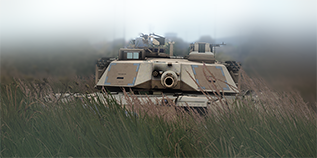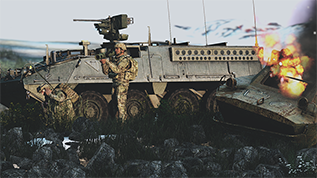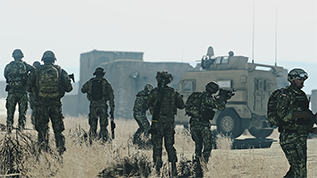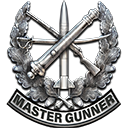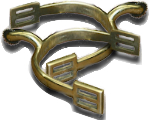The Cavalry School
Introduction
The Cavalry School (TCS) is a 1st Battalion (Arma 3) School operated as part of S37 Training, Headquarters and Headquarters Company, 1st Battalion. The Cavalry School delivers individual training at the crew level, from basic crew duties to advanced vehicle commander and leadership courses. The School is staffed primarily by 19K and 19D Troopers, however all MOS's are permitted to instruct, if they are qualified on the vehicle and course they are instructing. The School is designated the Functional Center of Excellence (FCoE) for all Armored, Mechanized Infantry, and Cavalry doctrine, tactics, and training.
The Cavalry School was re-named from "The Armor School", and "School of Armor" previously. The designation "SOA" was used until 2017, and in late 2018, the School was re-designated The Cavalry School to reflect the many roles of the School, teaching Armored, Cavalry, and Mechanized Infantry courses. The School is considered Platoon Strength, with the Commander also functioning as an Armored/Cavalry Platoon Commander if required.
The School delivers training along three broad pathways: Armored, Mechanized Infantry, and Cavalry Training.
Mission and Vision
The Mission of the Cavalry School is listed as: The Cavalry School will train and develop Armored, Mechanized Infantry and Cavalry Troopers and leaders in all aspects of mechanized and armored warfare in support of the Combined Arms Battalion for employment throughout the Spectrum of Conflict, in all environments including the worst case scenario- at night, in urban environments against a conventional adversary.
The Vision of the School is listed as: The Cavalry School will remain the functional Center of Excellence (FCoE) for all armored and mechanized operations. The Cavalry School will develop and maintain our knowledge of the capabilities of all armored fighting vehicles, from armored, armored reconnaissance, to mechanized forces. The School consists of the Army's best leaders and mentors, who strive to impart their expertise in the field of armored warfare on the next generation of Troopers and leaders through the delivery of high quality training at the individual level, from crewman to commander. The school will maintain the armored warfare doctrine and contribute to warrior lethality through development of further armored warfare material.
Armored Training
In the Armored Training Section, Troopers are instructed on all manner of operations related to the M1A2 SEP V1 Main Battle Tank (MBT). The goal of the Armored Training Section is to train individual Troopers on all crew roles in the M1A2, tactics, and capabilities of the platform. This training is delivered via three courses, The Basic Armor Crewman Course (BACC), Advanced Armor Crewman Course (AACC), and the Tank Commander Course (TCC).
Basic Armor Crewman Course (BACC)
The Basic Armor Crewman Course instructs Troopers in the 19K MOS field on the operation of the M1A2 SEP V1 Main Battle Tank as a Driver, Gunner, or Loader. The course is not limited to 19K Series MOS, however Armor Crewmen have priority for this class. Students are taught the capabilities and limitations of the M1A2, and all crew commands for driving, gunning, and loading. The course focuses largely on practical application, including on and off-road driving, and static gunnery against various types of targets. Students learn the different types of ammunition and weapons on an M1A2, and what ammunition is appropriate for each target. The Course is 2 hours long, delivered in one day.
| Pre-Requisites |
| Basic Land Navigation |
| Basic Individual Training |
| Basic Radio Communication Course |
Advanced Armor Crewman Course (AACC)
The Advanced Armor Crewman Course is designed to take qualified M1A2 SEP V1 crewmen and instruct them on the tactics of Armored Warfare. The course does not focus on crew commands, but the application of those skills in various engagements. Students are tested as both Driver, Gunner, and Loader on executing Action Drills, and Battle Drills. Troopers execute hull and turret down position occupation, in the context of defensive and offensive operations. Students also apply Battle Drills in live engagements under the command of a Platoon Leader, with the majority of emphasis on immediate reaction to commands and application of fire. The course is 2 hours long, delivered in one day.
| Pre-Requisites |
| Basic Land Navigation |
| Basic Individual Training |
| Basic Radio Communication Course |
| Basic Armor Crewman Course |
Tank Commander Course (TCC)
The Tank Commander Course trains Troopers who are already experienced Armor Crewmen to command an M1A2 as part of a Section and Platoon. The course consists of the capabilities and limitations of the M1A2, and navigation and route planning. New commanders are taught how to plan and execute movement, taking into account terrain, enemy, and time and space. The course also refreshes all crew commands previously taught on BACC. The course includes a substantial practical portion, where students are mentored and act as M1A2 Commanders by their instructors. The course concludes with Students taking command of an M1A2 SEP V1 without interruption from instructors, except for hot-washes at various points during the exercise. The course is 3 hours long, delivered in one day.
| Pre-Requisites |
| Basic Land Navigation |
| Basic Individual Training |
| Basic Radio Communication Course |
| Basic Armor Crewman Course |
| Advanced Armor Crewman Course |
Mechanized Infantry Training
The Mechanized Infantry Training Section is responsible to deliver and develop training and doctrine for the Regiment's mechanized infantry forces. The Section currently delivers training on both the M2A3 Bradley Fighting Vehicle (BFV) and M1126 Stryker Infantry Carrier Vehicle (ICV). Mechanized Infantry Training is similar to Armored training, and the crew skills taught are largely based upon those used on a Main Battle Tank. The main difference is that the Mechanized Infantry Section also teaches the skills required by Mechanized Infantrymen, including dismounting, mounting and operating alongside Infantry Fighting Vehicles (IFV).
| Pre-Requisites |
| Basic Land Navigation |
| Basic Individual Training |
| Basic Radio Communication Course |
Basic Mechanized Crewman Course (BMCC)
The Basic Mechanized Crewman Course trains Troopers to crew the M2A3 Bradley Fighting Vehicle and M1126 Infantry Carrier Vehicle (ICV). Troopers are taught the basics of the roles in each of the platforms, and the capabilities and limitations of both vehicles. Soldiers are taught to Drive, and operate the weapon systems of both vehicles. Similar to BACC, Students are taught the crew commands and responses used in both driving and gunnery. The course also includes a practical portion, where students operate M2A3 and M1126 vehicles, fire the weapon systems and participate in platoon level formations. The course is 2 hours long, delivered in one day.
| Pre-Requisites |
| Basic Land Navigation |
| Basic Individual Training |
| Basic Radio Communication Course |
Basic Mechanized Infantryman Course (BMIC)
The Basic Mechanized Infantryman Course teaches Troopers to safely mount, dismount, and operate alongside Infantry Fighting Vehicles. The course is delivered with a short theory portion, followed by a practical application of the skills. Students learn dismount patterns, the basic formations used when dismounting an IFV. Students also practice communicating with an IFV crew prior to mounting and dismounting. The course concludes with students applying the learned skills in a live-fire cumulative Field Training Exercise (FTX). The course is 2 hours long, and is delivered in one day.
| Pre-Requisites |
| Basic Land Navigation |
| Basic Individual Training |
| Basic Radio Communication Course |
| Basic Armor Crewman Course |
| Advanced Armor Crewman Course |
Infantry Fighting Vehicle Commander Course (IFVCC)
The Infantry Fighting Vehicle Commander Course teaches experienced IFV Crewmen the skills to take command of an M2A3 BFV or M1126 ICV. The course is similar in content and format to the Tank Commander Course. New commanders are taught how to plan and execute movement, taking into account terrain, enemy, and time and space. The course also refreshes all crew commands previously taught on BMCC. The course includes a substantial practical portion, where students are mentored and act as M2A3 or M1126 Commanders by their instructors. The course concludes with Students taking command of an M2A3 or M1126 without interruption from instructors, except for hot-washes at various points during the exercise. The course is 3 hours long, delivered in one day.
| Pre-Requisites |
| Basic Land Navigation |
| Basic Individual Training |
| Basic Radio Communication Course |
| Basic Mechanized Crewman Course |
Cavalry Training
Cavalry Scout Course (CSC)
The focus of Cavalry Training is to train Troopers to act as Cavalry Scouts, the eyes and ears of the Combined Arms Battalion Commander. This Section only delivers one course, the Cavalry Scout Course, or CSC. This is considered an advanced course, which combines knowledge from both Mechanized Infantry and Armored Training. Students learn the fundamentals, types, and categories of reconnaissance. Reconnaissance Troopers also learn their role, and the capabilities of various reconnaissance platforms. The practical portion begins with an overview of all the tools available to Cav Scouts, such as Global Positioning Systems, Small Unmanned Aerial Systems (SUAS), and HUNT-IR 40mm fired sensors. The practical portion also covers the fundamentals of occupying, and establishing an Objective Rally Point (ORP). Once an ORP has been established, students practice reconnoitering an objective. The practical portion concludes with students executing an Area Reconnaissance on a live objective. The course is 5 hours long, delivered over 2 days. Attendance on the first day is a pre-requisite for attending the second day.
| Day 1 Pre-Requisites |
| Basic Land Navigation |
| Basic Individual Training |
| Basic Radio Communication Course |
| Advanced Individual Training |
| Basic Leader Course |
| Basic Mechanized Infantryman Course |
| Day 2 Pre-Requisites |
| Basic Land Navigation |
| Basic Individual Training |
| Basic Radio Communication Course |
| Advanced Individual Training |
| Basic Leader Course |
| Basic Mechanized Infantryman Course |
| Cavalry Scout Course Day 1 |
Awards and Decorations
The Cavalry School awards two distinct awards for completion of training pathways: The Master Gunner Badge, and the Cavalry Spurs.
Master Gunner Badge
Completion of all Armored Pathway courses, including the Basic Armor Crewman Course, Advanced Armor Crewman Course and Tank Commander Course grants a Trooper the Master Gunner Badge.
Cavalry Spurs
Also known as the Order of the Spur, the Cavalry Spurs are a ceremonial device worn on the combat or dress boots of a qualified Cavalry Soldier. Awarded for completing both days of the Cavalry Scout Course, the Spurs represent the final achievement of the Cavalry Scout Pathway.

